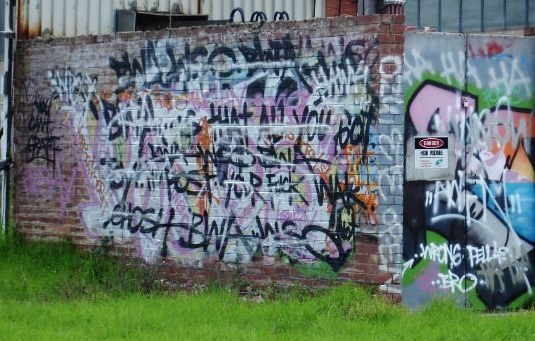Dr Max Darby
About Max
Max is a practising artist currently exhibiting work as a painter & photographer. He has worked in Art Education for many years, teaching Art across primary and secondary levels in both government and non-government schools. Max is a life member of Art Education Victoria and is a registered VIT teacher. He has run many workshops for teachers and students alike, and was also Worldwide Chief Examiner for IB Visual Art, allowing him to work work in many countries amongst variety of cultures.
Whenever possible, Max also runs sessions / speaks at Network Meetings, as well as being a seasoned presenter of Zart Workshops as well.
Street Art? Graffiti? Vandalism?



Dr Max refers to the Artworks above in this article – Read on
Dr. Max Darby (Art Education Consultant, Asia and Pacific)
This is not an academic article about Aesthetics or the nature of Art. It’s some of my ideas about the on-going debate on how we can make decisions concerning whether paintings, usually spray paintings, on exterior walls are of real value or are examples of vandalism and should be removed. The claim by some that they are all ‘Street Art’ and therefore have a right to be there, avoids many critical questions. For example, who or what gives those works a ‘right to be there’? This short personal article opens up some major issues, raises questions and offers some solutions. It probably also encourages further questions and different opinions that I’m happy to talk with anyone about privately.
Since the works we’re talking about take up public and private spaces the issue of whether they are legal or illegal is critical. While many ‘fine’ artists’ in the past have sometimes worked outside the desires and preferences of authority and influential people, they didn’t plaster community walls illegally. That might have been very dangerous! And, they always had a clear and strong reason, often political, for so doing. Many local businesses have been giving permission for works to be done on their premises, and that’s good.
However you refer to these works, legal or illegal, there are some important artistic characteristics that arise (or don’t arise) from the nature of the works themselves. Opinions to these and their quality vary enormously. But they should not be ignored (see descriptions below). As I say to art educators who often ignore talking to students about Street Art when I believe they are obligated to do so – If you can buy books on Street Artist, Banksy, in National Galleries (London, New York, Canberra and Melbourne, for example) then it’s already been accepted and acknowledged as a valid artform. It can even be included in the VCE! And, the NGV has recently shown the works of early pioneers of Street Art Keith Haring and Jean-Michel Basquiat. Following are some points to assist your decision-making when confronted by a new work in your area, or even on your own fence or wall. I believe that if such things appear on your property without your permission, you have a moral
obligation to have it removed as soon a possible. If you don’t, then expect more to be soon added regularly. Tagging invites more tagging.
Three examples have been included to help describe what is being said. Example 1, clearly meets the ‘usual’ expectations of traditional artworks. Example 2, which is quite different, meets some of those expectations and Example 3 meets none of those expectations.
Firstly, it is expected that for a ‘work’ to be considered art and of value it needs these things – The demonstration and use of appropriate skills and technical qualities; the demonstration and use of appropriate design qualities; the attempt to communicate worthwhile meanings and/or messages and, a worthwhile intention or purpose for being made. The last two can often merge into one.
In terms of appropriate skills and working techniques look at the three examples and think about how skilful each maker has been. That is, ‘how well the artist has worked’. Of course, they vary enormously. I contend that Example 1 is by far the best example of this as it is highly skilful and uses appropriate technical qualities consistently. It is made using spray-can paint that shows variations in colour and tones as well as an excellent knowledge of the structure of the human face. Example 2 shows a different and simpler use of skills and appropriate technical qualities that are useful in creating patterns and repetition. Actually the whole work is repetitive of thousands of other such examples that can be found in most suburbs, so it is not unique. In fact seeing them becomes boring as examples are everywhere. Example 3 demonstrates none of these qualities, not even a consistent use of felt markers. They appear totally unskilful and hurried. What marks would you allocate for skills and technical qualities to each example on a 10 – 1 scale where 10 is for the best?
In terms of the demonstration of the use of appropriate design qualities Example 1 shows a central placement of the head and face, the variations in tones and colours to create the effects of light and shade, the creation of depth with facial features looking close up or far away, highlights on the forehead, nose and cheeks emphasise the age and character of the person, and the face looking to the side shows a relaxed and comfortable person. All of this through the use of design. Example 2 has strong design features with colours that both contrast and blend. In fact this is its strength. Look at the lovely variations of colour tones in the green and blue areas of the work. Example 3 appears to have none of these features. What marks would you allocate for appropriate design qualities to each example on a 10 – 1 scale where 10 is for the best?
In terms of the attempt to communicate worthwhile meanings and/or messages Example 1 once again leads the way with very strong and emotional meanings suggested. And, it’s quite clear what the intention and purpose is of the work being made. It is clearly a memorial work paying tribute to a valued, but lost Father. It is easy to relate to this message due to the qualities already outlined above. It is a carefully and lovingly designed art work. Even the birth and death dates have been included. Everything in the painting works together to create feelings of compassion and sympathy. Example 2 is difficult to interpret due to the style of lettering, although the shapes are clear it is almost impossible to read any of the words, let alone understand why the work was made. Its main purpose seems to be to make something patterned and colourful, and something like most other people do. And, that’s fine and it works, though in a rather limited way. Example 3 is a hotchpotch of tags with old faded colours below. There is no effort at respect for previous artists or anyone else. In terms of worthwhile and meaningful messages, there seems to be no evidence of those whatsoever. It makes you wonder why anyone would want to do that. Certainly not to demonstrate artist
intent, talent or intelligence! What marks would you allocate for communication of meanings and messages to each example on a 10 – 1 scale where 10 is for the best?
By carefully analysing supposed art works on walls as you and I have tried to do above, we gain a lot of indicators that we can use to try to decide on the value of art generally and so called Street art in particular.
It is my contention that after carefully analysing the three examples that Example 1 can be considered an outstanding version of worthwhile Street Art, Example 2, has more limited though some interesting qualities and can generally be considered as Graffiti or lower quality Street Art, and Example 3 is simply not art at all. Tagging, as it’s called, is worthless and ugly. What do you think? I often treat good artworks as good friends. You want to see than often and enjoy the interaction between you and them. Well, that’s a good approach to take to art of any kind, but especially works in public places. Do you want to see then again and again? If not, then it’s a work you should query.
Neighbourhood Watch is deeply concerned that the quality of acceptable Street Art is continually improved. Look around the City of Bayside to make yourself aware of the enormous steps that have already been taken towards this end. It is also concerned that action is taken to remove Tagging that can only be described as vandalism.
Finally, I’m if asked what is the best way for a prospective Street Artist to get a start, I always say, go to Art School and study Art and Design. Never do anything illegal and forget the Tagging. It’s rubbish that makes you look really bad.
Have your say.
Email any comments to
haveyoursay@nhw3193.com.au